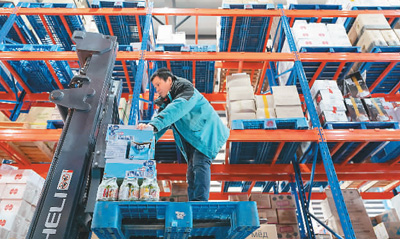Cross-border e-commerce drives growing presence of Chinese products overseas
Data recently released by the statistical department of South Korea has attracted attention. In 2023, the import volume of cross-border e-commerce from China to South Korea witnessed a remarkable 121.2 percent year-on-year increase. This marked the first time that China surpassed the U.S. as South Korea's largest source of cross-border e-commerce imports.
This serves as another testament to the rapid growth of China's cross-border e-commerce. According to the Ministry of Commerce, China's cross-border e-commerce imports and exports reached 2.38 trillion yuan ($331.1 billion) in 2023, representing a 15.6 percent year-on-year increase. Among these figures, exports accounted for 1.83 trillion yuan, reflecting a year-on-year increase of 19.6 percent.

A cargo ship waits to load and unload goods at Shidao Xingang port in Rongcheng city, east China's Shandong Province. The port serves as a transit port for cross-border e-commerce. (Photo/Li Xinjun)
On Feb. 4, a cargo plane carrying various cross-border e-commerce goods, including clothing, shoes, accessories, and daily necessities, departed from Kashgar Laining International Airport in northwest China's Xinjiang Uygur Autonomous Region, for Bournemouth, the UK. These goods were prepared by Chinese manufacturers for popular cross-border e-commerce platforms like Amazon and Wish.
"We provide services such as procurement, logistics, and product information collection for foreign cross-border e-commerce platforms. We help our overseas clients purchase whatever they need, be they small items like hair ties and hair clips, or larger items like generators and machine tools," explained Zhang Qi, head of a supply chain technology company in Xinjiang.
Kashgar possesses a unique geographical advantage. Its aviation economic circle covers major cities in neighboring countries such as Pakistan and Tajikistan within a 1.5-hour radius.
According to Zhang, Kashgar Customs currently operates a 24/7 appointment clearance system, ensuring the efficient processing of clearance procedures and standardizing the arrival, inspection, and release process. This enables businesses to devote more to expanding their customer base in the European market while also strengthening their presence in Central Asia and South Asia.

Workers assemble cars for children at the factory of a toy manufacturer in Xingtai, north China's Hebei Province. The products will be exported to the U.S. and Germany. (Photo/Zhao Yonghui)
Huang Kai is an entrepreneur born in 1999 in Shaoyang, central China's Hunan Province. After graduating from college, Huang realized the fierce competition in the dining table and chair industry. Recognizing the challenges of making significant progress in a short time, Huang shifted his focus to online platforms.
"While a container can hold 2,000 dining tables and chairs, it can only accommodate 18 sofa sets. This has made many companies hesitant to venture into sofa exports. However, there is a substantial demand for sofas from international customers," Huang said.
With a clear vision, he embarked on exploring the export market for functional and combination sofas tailored for the European and American markets, with his uncle's assistance.

An employee works inside a smart warehouse in a cross-border e-commerce park in Heihe city, northeast China's Heilongjiang Province. (Xinhua/Xie Jianfei)
Since its establishment a year and a half ago, Huang's furniture company has experienced remarkable growth, surpassing the monthly export revenue of over 2 million yuan in 2023. With this positive trend, it is anticipated that the company's monthly export revenue will reach 3 to 4 million yuan in 2024.
Cross-border e-commerce platforms in the U.S. are well-known, and now China also has powerful and renowned cross-border e-commerce platforms, with high global rankings in terms of app downloads, said China's Vice Commerce Minister Wang Shouwen.
According to data provided by Shanghai Customs, the number of cross-border e-commerce declarations for export at Shanghai's airports reached a record-breaking 440 million in 2023, nearly double compared to the previous year.
The total export value exceeded 85 billion yuan. Notably, emerging Chinese e-commerce platforms like AliExpress, Shein, and Pinduoduo exhibited exceptional performance, collectively reaching a peak daily order volume of over 400,000.

Customs staff inspect imports and exports at a cross-border e-commerce management center in Urumqi, northwest China's Xinjiang Uygur Autonomous Region. (Photo/Liu Jiacheng)
Cross-border e-commerce is propelling Chinese products onto the global stage, enabling them to enter the daily lives of consumers around the world, and bringing China closer to the international community.
"I want to recommend Luosifen to more overseas Chinese," said Zheng Xiaozhen, a returned overseas Chinese who previously lived in Canada. Luosifen, or river snail rice noodles, is a unique local snack in Liuzhou, south China's Guangxi Zhuang Autonomous Region.
According to Ou Haoxuan, head of the overseas division of No. Wang, a river snail rice noodle company based in Liuzhou, the company has been deeply cultivating overseas markets through cross-border e-commerce in recent years, entering key markets such as the U.S., Canada, and Southeast Asia with their flagship products.
"Currently, we are creating new products tailored to the preferences of consumers in various regions. Additionally, we are refining our localized marketing strategies and seeking collaborations with renowned international bloggers to enhance the global visibility and impact of our products," he explained.
At the end of 2023, a Romanian merchant dressed as Santa Claus riding a Jinpeng electric tricycle manufactured in China to distribute New Year gifts to children attracted significant attention.
Hou Dafu, brand manager of the overseas platform of Jiangsu Jinpeng Group Co., Ltd., a manufacturer of electric tricycles based in east China’s Jiangsu Province, said that electric tricycles, serving as important civilian production and transportation tools, have traditionally relied on offline stores for sales. However, in recent years, as the number of offline stores has grown and costs have risen, the overseas market has emerged as a significant growth driver for companies seeking to expand their business.
"Since 2019, our annual export volume has consistently grown by over 30 percent, covering more than 80 countries and regions in the world. Our foreign trade team has also grown from five to over 60 members," Hou said.
Data from the Ministry of Commerce showed there are 645,000 enterprises in China engaged in import and export activities, with over 100,000 of them participating in cross-border e-commerce. The distinctive advantages of Chinese manufacturing, combined with the robust demand in overseas markets, have greatly bolstered the confidence of cross-border e-commerce practitioners.
Photos
Related Stories
- China sees rapid growth of cross-border e-commerce exports
- Shanghai's airports record soaring cross-border e-commerce exports
- China's e-commerce logistics index up in 2023
- Shenzhen reports surge in cross-border e-commerce trade in 2023
- China remains world's largest online retail market for 11 years: ministry
- China's "porcelain capital" shines in livestreaming spotlight
- Tianjin's cross-border e-commerce trade tops 1.6 bln USD in Jan.-Nov.
Copyright © 2024 People's Daily Online. All Rights Reserved.









